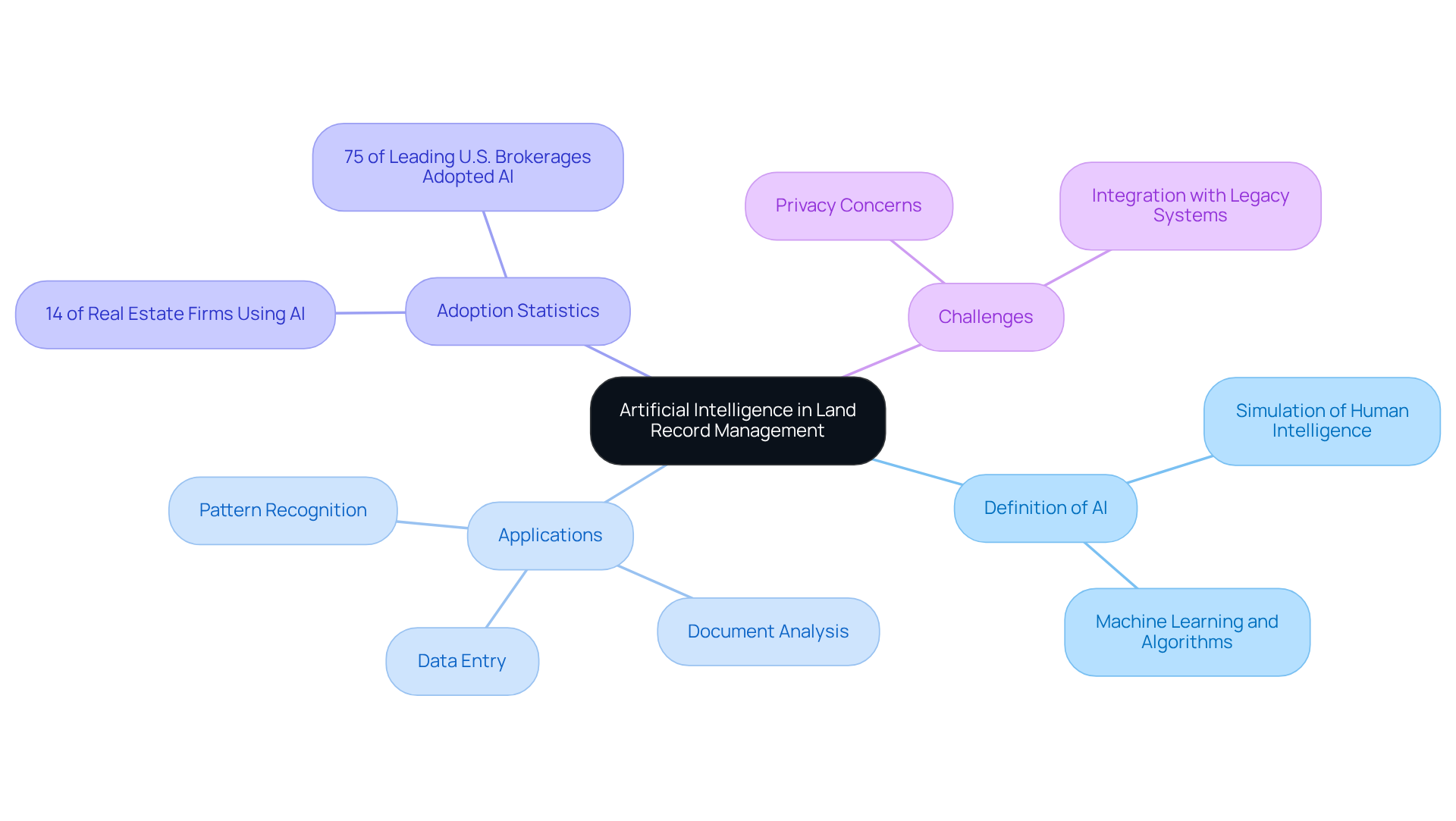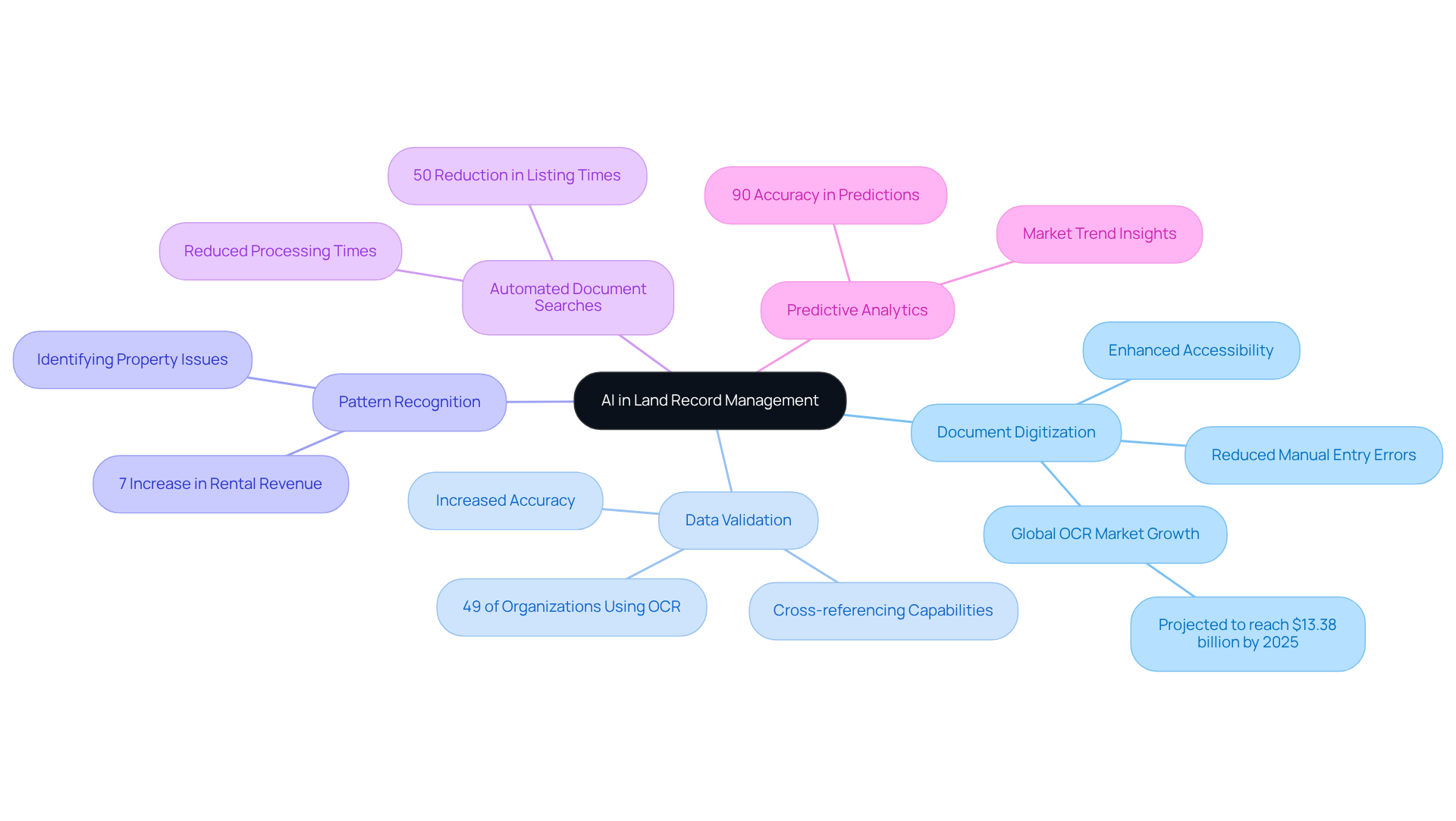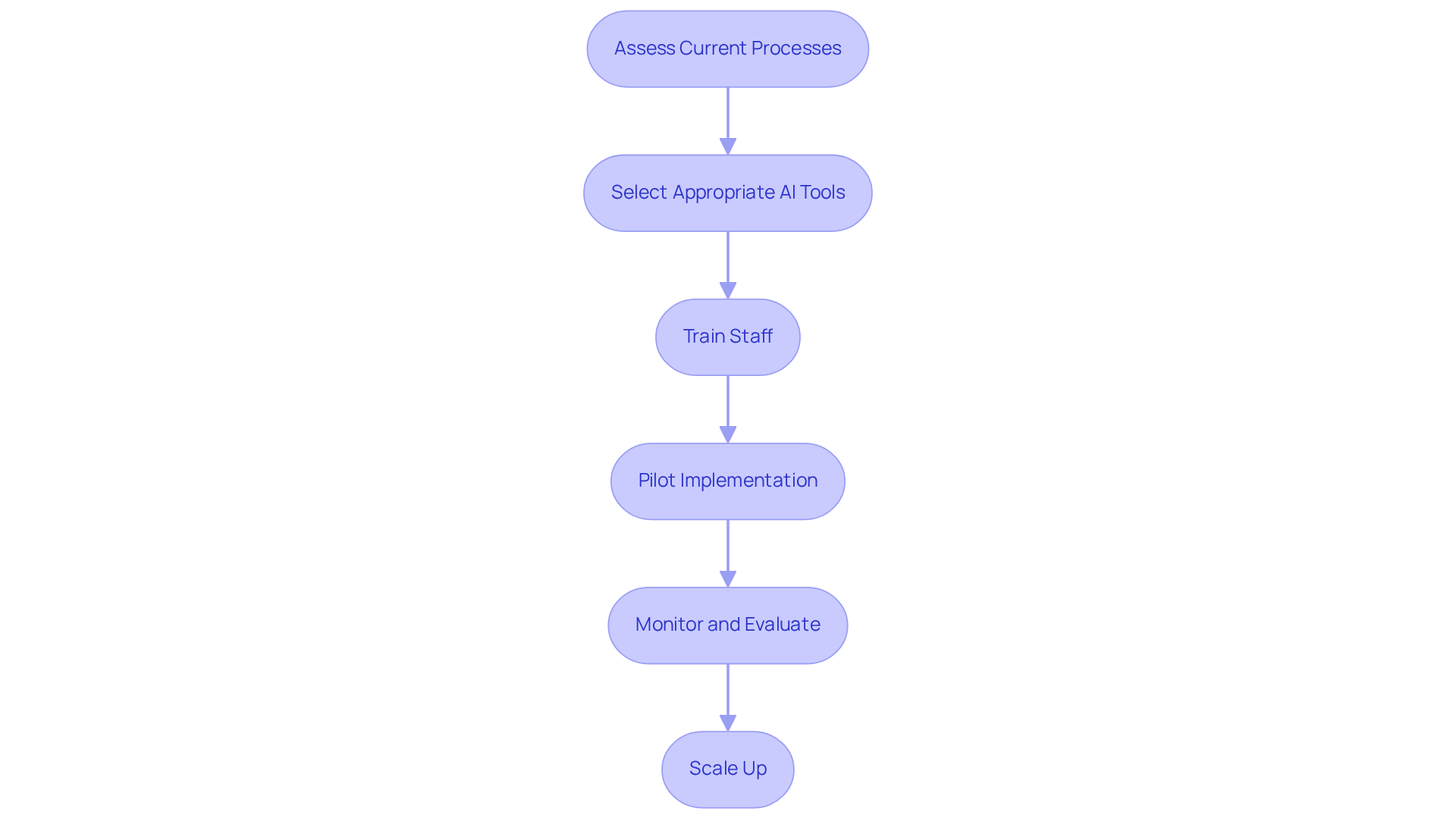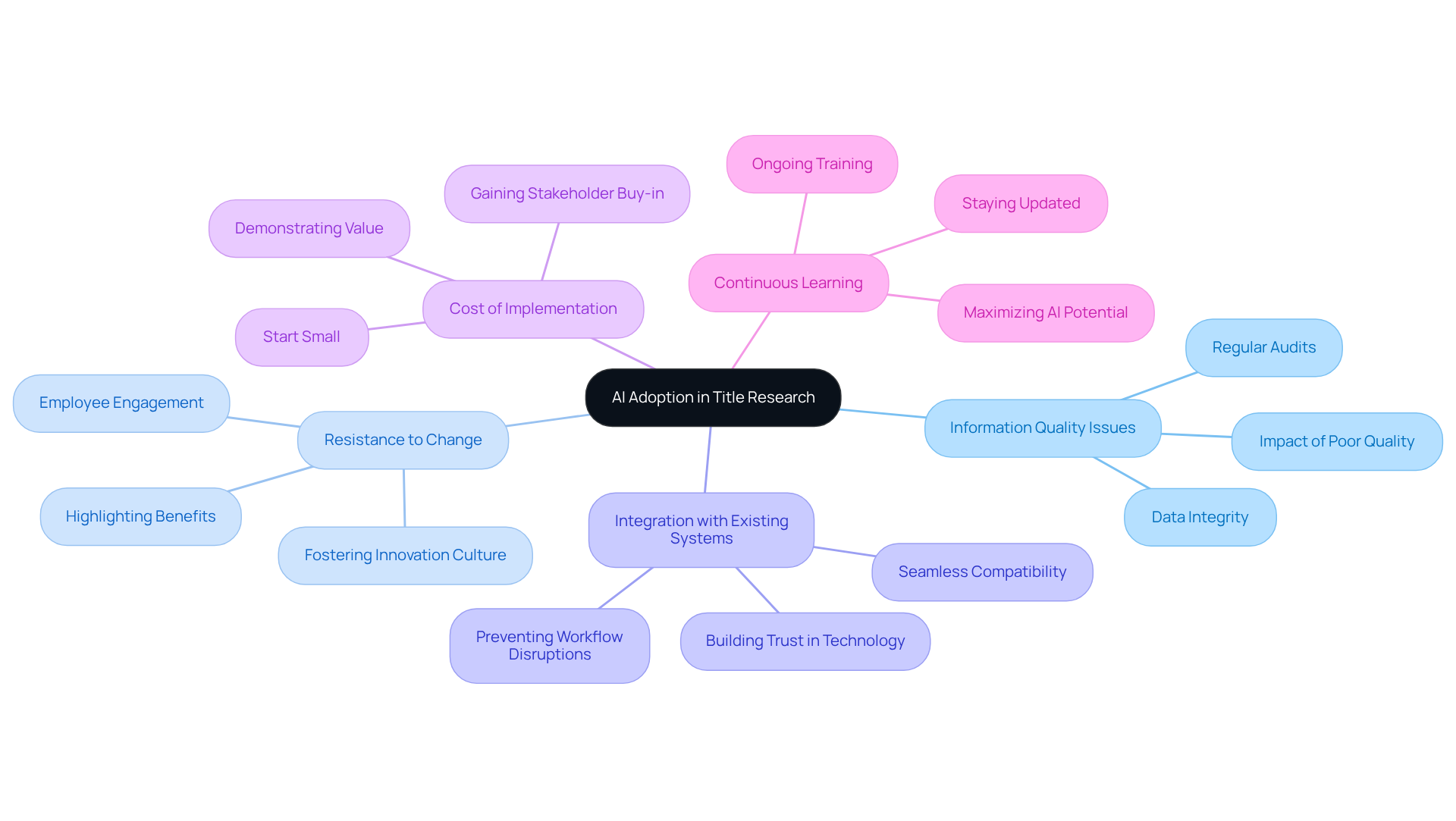Overview
AI transforms land record management for title researchers by automating essential tasks such as data entry, document analysis, and pattern recognition. This automation significantly enhances efficiency and accuracy in property management. Furthermore, the article illustrates how AI technologies, including Optical Character Recognition (OCR) and predictive analytics, streamline workflows, reduce costs, and improve decision-making in real estate. Consequently, AI emerges as an indispensable tool for modern title research, reinforcing its critical role in the industry.
Introduction
Artificial Intelligence (AI) is reshaping industries at an unprecedented pace, and the realm of land record management is no exception. Title researchers face the complexities of property documentation, where AI emerges as a powerful ally, streamlining processes and enhancing accuracy. However, the integration of such technology raises important questions regarding its potential challenges and the best practices for successful implementation.
How can title researchers effectively leverage AI to transform their workflows while navigating the hurdles that accompany this technological shift?
Define Artificial Intelligence and Its Role in Land Record Management
Artificial Intelligence (AI) represents the simulation of human intelligence processes by machines, particularly computer systems. In the realm of property management, exploring how AI is used in land record management is critical for automating tasks that traditionally required human involvement, such as:
- Data entry
- Document analysis
- Pattern recognition
By employing advanced machine learning algorithms and optical character recognition (OCR), this process illustrates how AI is used in land record management to effectively process vast collections of document titles, identify discrepancies, and streamline workflows. This capability not only enhances precision but also significantly reduces the time and costs associated with property management.
As of 2024, approximately 14% of real estate firms have integrated AI technologies, while a significant 75% of leading U.S. brokerages have adopted these innovations, reflecting an increasing acknowledgment of AI's potential. Industry leaders assert that AI can elevate human productivity and unlock new economic opportunities, establishing it as an indispensable asset for title researchers and real estate professionals.
Furthermore, AI-driven tools can forecast property price trends with 95% accuracy and predict lease renewals with 70% accuracy, facilitating informed investment decisions and optimizing resource allocation. The integration of how AI is used in land record management within property management is not merely a passing trend; it signifies a pivotal transformation poised to redefine efficiency and effectiveness within the sector. However, it is essential to consider potential challenges, such as privacy concerns, as AI applications become more prevalent.

Explore Key Applications of AI in Land Record Management
AI is revolutionizing land record management through several key applications:
-
Document Digitization: Leveraging advanced Optical Character Recognition (OCR) technology, AI transforms physical documents into digital formats, facilitating easier search and analysis. This transition not only enhances accessibility but also significantly reduces the time spent on manual information entry, which is often prone to errors. The global OCR market is projected to reach $13.38 billion by 2025, underscoring the critical role of digitization in updating property documentation.
-
Data Validation: AI algorithms excel at cross-referencing information from various sources, identifying inconsistencies or errors in land documentation. This capability ensures a higher level of accuracy, which is vital for maintaining reliable property ownership information. According to AIIM, 49% of organizations are utilizing OCR to drive their digital transformation, highlighting the importance of precise information validation.
-
Pattern Recognition: By analyzing historical data, AI can uncover patterns that may indicate issues such as overlapping property boundaries or duplicate ownership entries. This proactive approach helps mitigate potential disputes before they arise. Furthermore, AI's ability to analyze data can lead to a 7% increase in rental revenue by predicting optimal pricing, showcasing its broader implications in real estate.
-
Automated Document Searches: AI streamlines the search process by swiftly scanning databases for liens, easements, and ownership records. This efficiency significantly reduces processing times, allowing researchers to focus on more strategic tasks. AI-driven property listing platforms can cut listing times by 50% through automated data entry and image recognition, demonstrating the potential for enhanced operational efficiency.
-
Predictive Analytics: AI's ability to assess market trends and property values provides researchers with valuable insights, empowering them to make informed decisions. This predictive capability can enhance the overall efficiency of research operations related to titles. As highlighted by Forbes Tech Outlook 2024, AI has evolved from being merely an add-on in the real estate industry to a driving force behind innovation, efficiency, and growth.
The integration of AI in document digitization illustrates how AI is used in land record management, boosting operational efficiency while enhancing the precision and reliability of property documents, ultimately benefiting researchers and the real estate sector as a whole.

Implement AI Solutions: A Step-by-Step Guide for Title Researchers
A strategic approach is necessary for implementing AI solutions in land management, particularly in how AI is used in land record management, to significantly enhance the efficiency and precision of ownership research. This guide outlines the essential steps:
-
Assess Current Processes: Start by evaluating existing workflows to identify inefficiencies and determine specific areas where AI can drive enhancements. Focus on repetitive tasks and data-heavy processes that stand to benefit from automation.
-
Select Appropriate AI Tools: Conduct thorough research to choose AI tools tailored to your needs. Options may include document digitization software for converting paper records into digital formats, or predictive analytics platforms that forecast trends based on historical data.
-
Train Staff: It is crucial that team members receive comprehensive training on the selected AI tools. This training should encompass not only technical aspects but also best practices for integrating these tools into daily workflows, fostering a culture of comfort and proficiency with the technology.
-
Pilot Implementation: Initiate a pilot project to test the AI tools in a controlled environment. This approach allows for real-time feedback and adjustments, ensuring that the tools effectively meet the team’s needs before a full-scale rollout.
-
Monitor and Evaluate: Continuously monitor the performance of the AI tools post-implementation. Gather user feedback to assess their impact on workflow efficiency and accuracy, making necessary adjustments to optimize performance.
-
Scale Up: Once the pilot proves successful, gradually expand the implementation across the organization. Integrate AI into all relevant processes, ensuring a smooth transition and providing support to all team members throughout the scaling process.
By following these steps, researchers can effectively harness the power of AI, particularly in how AI is used in land record management, resulting in substantial time savings and enhanced accuracy in their workflows.

Address Challenges and Best Practices in AI Adoption for Title Research
Integrating AI into title research presents several challenges that require careful consideration and strategic planning. The significance of accurate title research cannot be overstated, as it lays the groundwork for effective decision-making. However, several key obstacles must be navigated effectively to harness the full potential of AI in this field.
-
Information Quality Issues: The foundation of effective AI training relies on the precision and promptness of the information utilized. Regular audits and updates of information quality are essential to ensure that the input feeding into AI systems is reliable. Inferior information quality can result in considerable obstacles, as emphasized by industry specialists who assert, 'if your information quality is questionable, then your AI will be learning incorrectly.' This underlines the necessity for organizations to prioritize data integrity.
-
Resistance to Change: Furthermore, to foster a culture of innovation, it is crucial to involve staff in the AI adoption process. Highlighting the tangible benefits of AI tools can help alleviate concerns and encourage acceptance among team members. Engaging employees in this transition not only enhances buy-in but also promotes a collaborative environment.
-
Integration with Existing Systems: In addition, selecting AI solutions that seamlessly integrate with current systems is vital to prevent workflow disruptions. This approach not only enhances efficiency but also builds trust in the new technology. Ensuring compatibility with existing frameworks is essential for a smooth transition.
-
Cost of Implementation: Consequently, initiating AI adoption with smaller, cost-effective solutions allows organizations to demonstrate value before committing to larger investments. This gradual approach can help in gaining buy-in from stakeholders, showcasing the benefits of AI without overwhelming financial commitments.
-
Continuous learning is essential, as ongoing training and development for staff are necessary to keep pace with advancements in how AI is used in land record management and best practices. As noted by experts, maintaining high data quality and understanding AI's capabilities are critical for maximizing its potential in title research. This commitment to continuous learning ensures that organizations remain competitive in an evolving landscape.

Conclusion
The transformation of land record management through artificial intelligence signifies a groundbreaking shift in how title researchers operate. By integrating AI technologies, the sector can automate tedious tasks, enhance accuracy, and streamline workflows, ultimately revolutionizing property management. This evolution underscores the importance of embracing AI not merely as an addition to existing processes but as a fundamental component that can drive efficiency and innovation.
Key applications of AI, such as:
- Document digitization
- Data validation
- Predictive analytics
highlight the myriad ways in which these technologies enhance the precision and reliability of land records. The ability to process vast amounts of information quickly and accurately not only saves time but also empowers researchers to make informed decisions based on data-driven insights. Furthermore, addressing the challenges of AI adoption, including information quality and staff resistance, is crucial for maximizing its benefits in title research.
As the landscape of land record management continues to evolve, embracing AI technologies will become ever more critical. Organizations are encouraged to take proactive steps in implementing AI solutions, ensuring they remain competitive in an increasingly data-driven world. By prioritizing training, fostering a culture of innovation, and continuously refining data integrity, title researchers can harness the full potential of AI, paving the way for a more efficient and effective future in property management.
Frequently Asked Questions
What is Artificial Intelligence (AI) in the context of land record management?
Artificial Intelligence (AI) refers to the simulation of human intelligence processes by machines, particularly in automating tasks in land record management that traditionally required human involvement, such as data entry, document analysis, and pattern recognition.
How does AI enhance land record management?
AI enhances land record management by employing advanced machine learning algorithms and optical character recognition (OCR) to process large collections of document titles, identify discrepancies, and streamline workflows, resulting in increased precision and reduced time and costs.
What percentage of real estate firms have integrated AI technologies as of 2024?
As of 2024, approximately 14% of real estate firms have integrated AI technologies into their operations.
What is the significance of AI adoption among leading U.S. brokerages?
A significant 75% of leading U.S. brokerages have adopted AI innovations, indicating a growing recognition of AI's potential to enhance productivity and create new economic opportunities in the real estate sector.
How accurately can AI forecast property price trends and predict lease renewals?
AI can forecast property price trends with 95% accuracy and predict lease renewals with 70% accuracy, aiding in informed investment decisions and optimizing resource allocation.
What challenges are associated with the increasing use of AI in land record management?
Potential challenges include privacy concerns as AI applications become more prevalent in managing sensitive property information.




